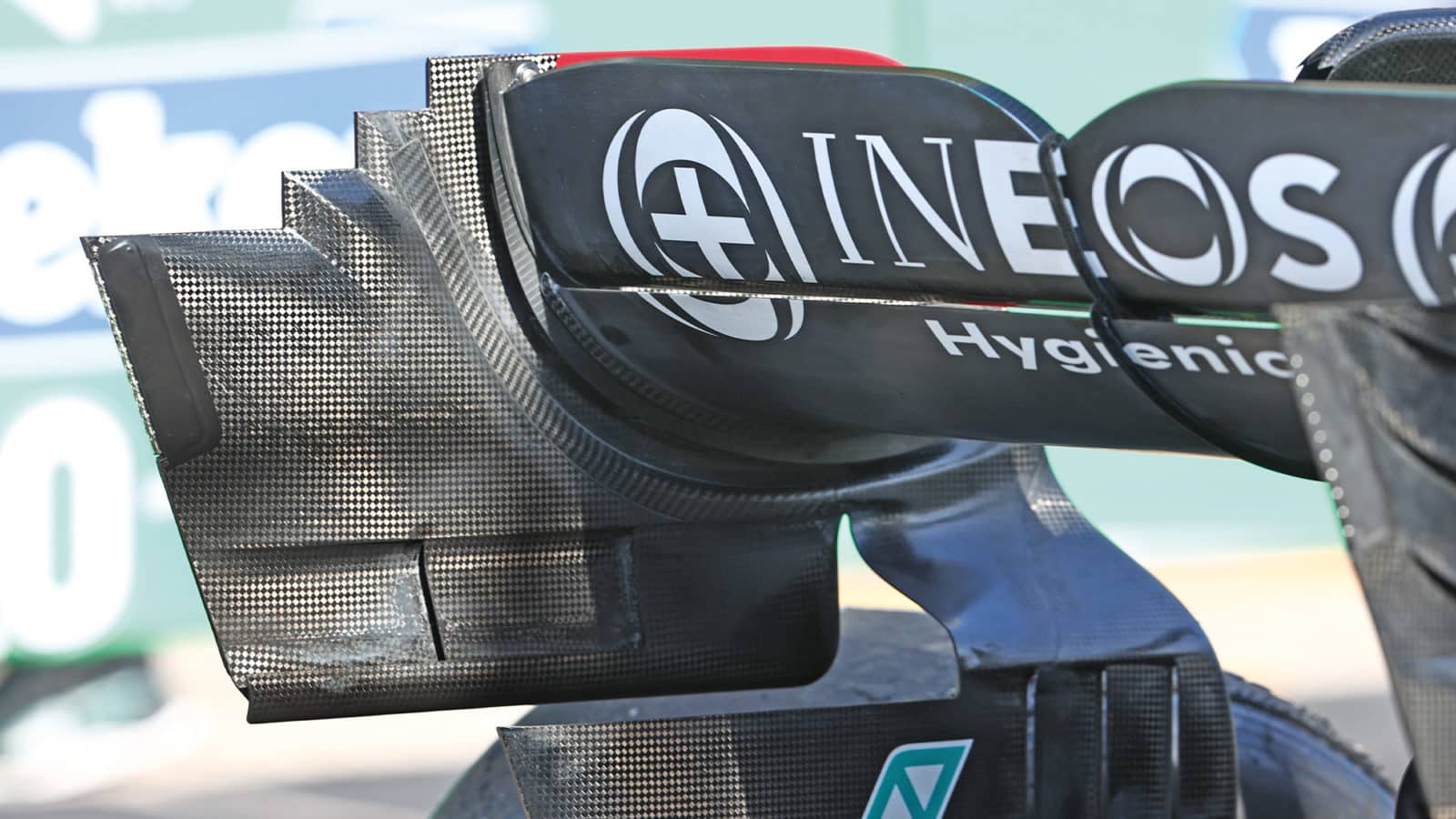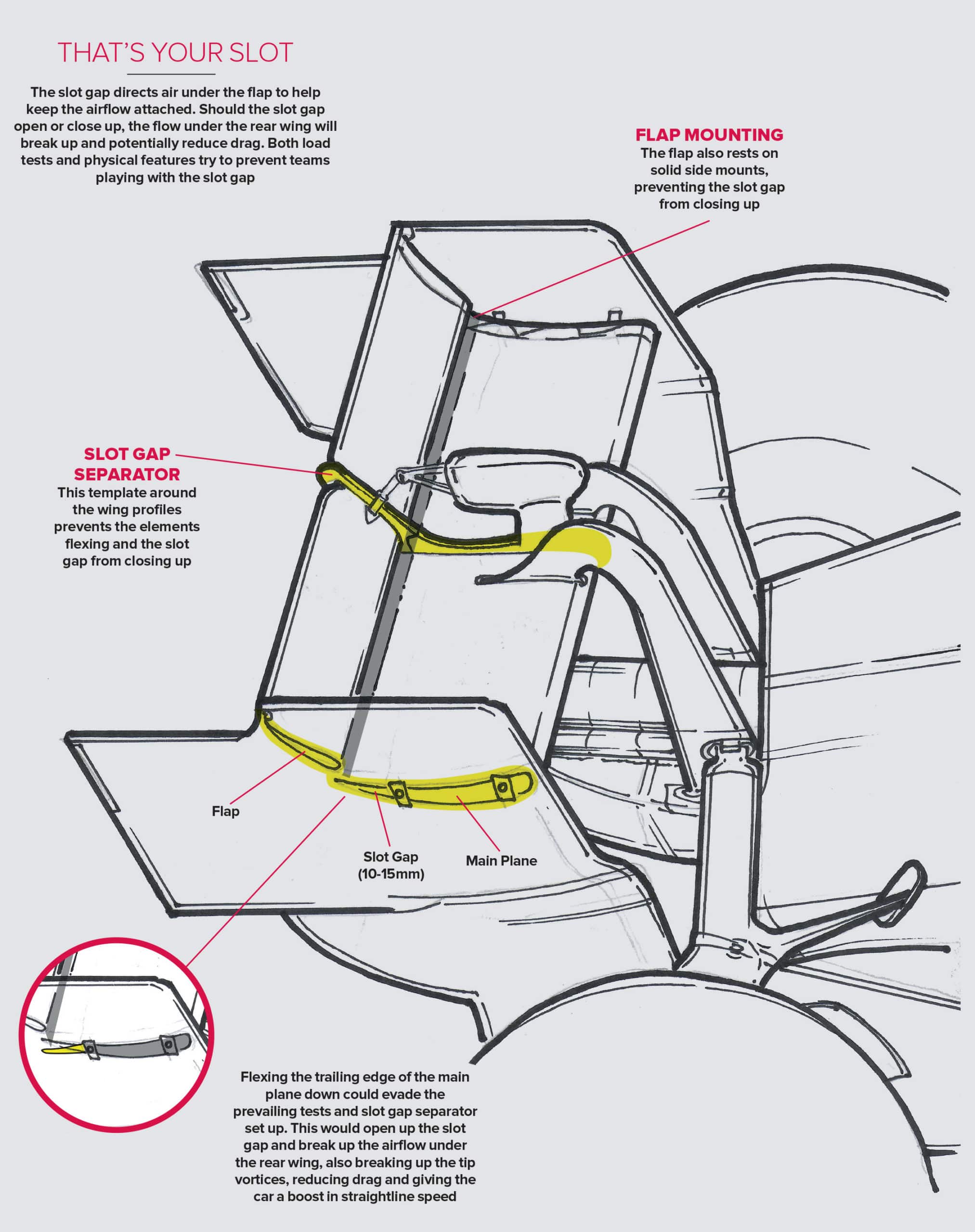The mysterious case of F1's flexing rear wings
Regulators strive to stiffen the rules, but team designers keep trying to search out gaps

Red Bull obtained end plate photos which it claimed showed scuffing, proving flap movement at the slot gap invisible to the rear-facing cameras
Red Bull’s Christian Horner was adamant during the Brazilian Grand Prix that Mercedes had somehow got around the tougher rear wing flexibility tests introduced earlier this season. These were brought in from the French Grand Prix after Mercedes queried Red Bull’s flexing rear wing in Spain.
At least seven of the 10 teams were believed to be using flexibility in the wing mounting to bend the whole construction back and downwards. But they were all passing the regulation static load test. This however did not automatically mean they were legal – because there is a regulation (article 3.8) which states that any bodywork “must be rigidly secured to the entirely sprung part of the car (rigidly secured means not having any degree of freedom)”.
The June technical directive said the FIA reserved the right to test up to 1.5 times the regulatory limit and in addition would use visual evidence of flexing captured by the rearward-facing cameras as measured against bodywork markings the teams were obliged to apply.

Regulation 3.9.6 concerns the wing flap. “The uppermost aerofoil element lying behind the rear wheel centre line may deflect no more than 7mm horizontally when a 500N load is applied horizontally. The load will be applied 870mm above the reference plane at three separate points which lie on the car centre plane and 270mm either side of it. The loads will be applied in a rearward direction…”
So if a wing passed the load test by flexing only 7mm at 500N, and assuming its flex was linear to the load (not necessarily the case), that implies as much as 18mm of flex at the load the wings were actually seeing at 150mph. And at 200mph, considerably more than that.
Regulation 3.9.7 concerns the wing main plane. “The forward-most aerofoil element lying behind the rear wheel centre line and which lies more than 630mm above the reference plane may deflect no more than 2mm vertically when a 200N load is applied vertically. The load will be applied in line with the trailing edge of the element at any point across its width.”
Here the difference between load test and the actual load on track is more dramatic – something like 15 times more. So that 2mm static flex could in theory be 30mm or more out on track.
Although most or all of the teams were believed to be taking advantage of this discrepancy, it was very much in Mercedes’ interest in its battle with Red Bull to point this out. Because the Red Bull, being a high-rake car, has a whole lot more drag to dump than the low-rake Mercedes. So in theory the tougher implementation of the regulation from France would have slowed Mercedes – but more importantly it would have slowed Red Bull a lot more. Hence Red Bull saw that campaign by Mercedes as very much politically motivated and that was the backdrop to why it was irritated by what it believed Mercedes was doing in Brazil – which, if true, would get around the June technical directive.
“No bones about it, if weseeiton the car here it will be protested”
Mercedes had achieved this, Horner believed, through flexing the trailing edge underside of the wing flap. This could give a stall effect beyond a certain threshold which would boost straightline speed but without it being captured on the rearward-facing camera and bodywork markers.
“You can see the straightline performance since Hungary, and particularly in the last two grands prix, has gone exponential,” said Horner in Qatar one week after Brazil, “and that obviously concerns us… Make no bones about it, if we see it on the car here it will be protested.”
Red Bull leaked images taken in Brazil of scuff marks around the Mercedes endplates which it claimed were evidence of the flexing flap. Red Bull personnel, including Adrian Newey, were in deep discussion with FIA technical delegate Nikolas Tombazis in Brazil pressing their case.
“I can’t see anything on this photo other than stuff being scratched – a ghost,” Mercedes team boss Toto Wolff said. “I don’t know where they got this photo from or what it shows.”
For Qatar the FIA informed the teams it would be conducting an experimental new flexibility test “without any regulatory value” (i.e. there would be no penalty for failing it) as part of a process to define further regulation in future. This test was carried out – and every car passed it comfortably, including the Mercedes.
Horner believes that, with the foreknowledge of the test, Mercedes had changed its wing so as not to flex in Qatar. The wings used by Mercedes in Brazil and Qatar were visually identical, but there is no reason why a flexing underside would look any different to one which did not. The difference would only be in the carbon lay-up of the two surfaces.
Ghosts, or clever lateral laminate thinking? Very F1…

